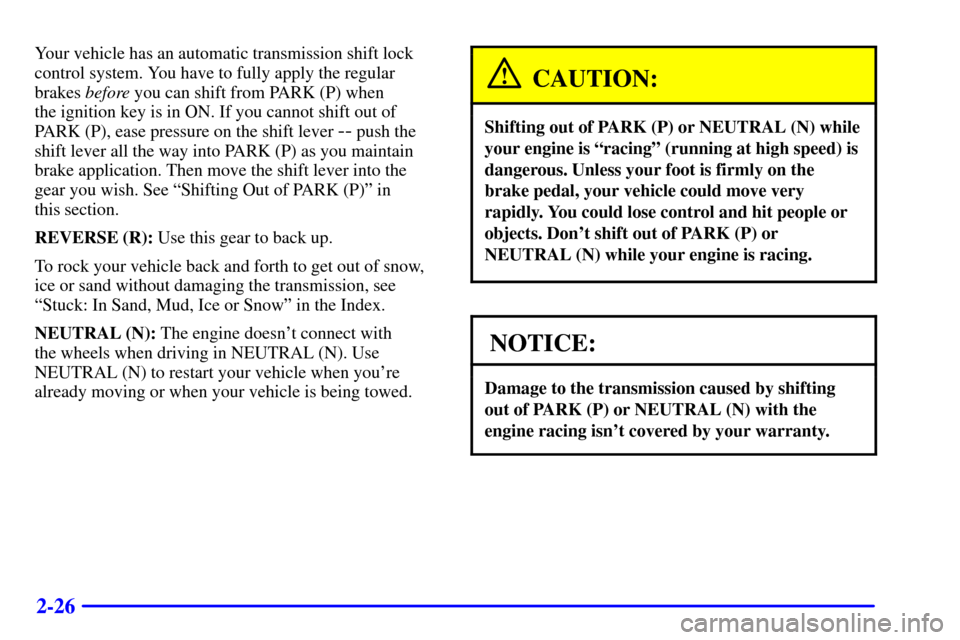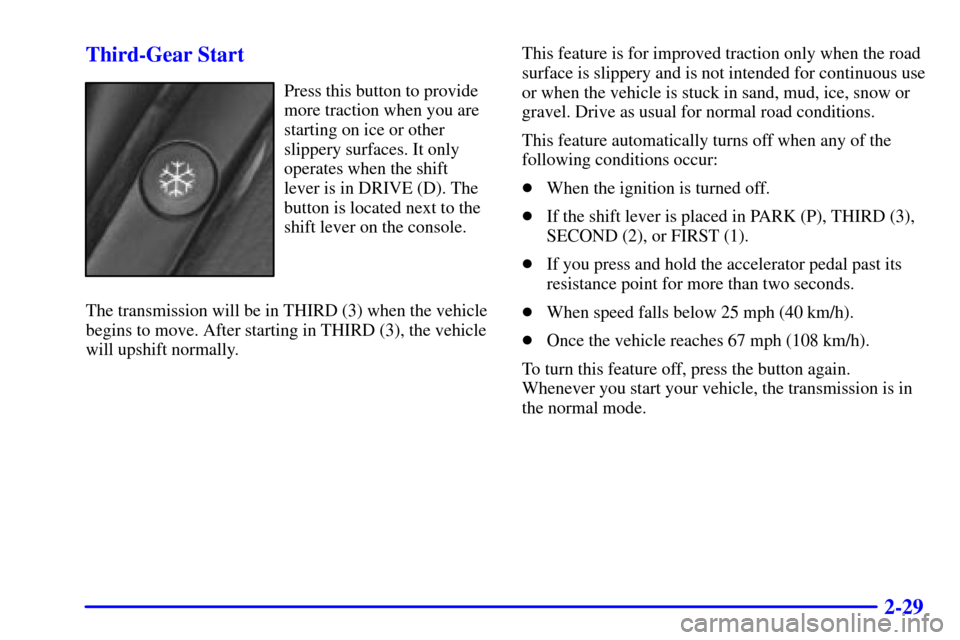Page 93 of 328

2-26
Your vehicle has an automatic transmission shift lock
control system. You have to fully apply the regular
brakes before you can shift from PARK (P) when
the ignition key is in ON. If you cannot shift out of
PARK (P), ease pressure on the shift lever
-- push the
shift lever all the way into PARK (P) as you maintain
brake application. Then move the shift lever into the
gear you wish. See ªShifting Out of PARK (P)º in
this section.
REVERSE (R): Use this gear to back up.
To rock your vehicle back and forth to get out of snow,
ice or sand without damaging the transmission, see
ªStuck: In Sand, Mud, Ice or Snowº in the Index.
NEUTRAL (N): The engine doesn't connect with
the wheels when driving in NEUTRAL (N). Use
NEUTRAL (N) to restart your vehicle when you're
already moving or when your vehicle is being towed.
CAUTION:
Shifting out of PARK (P) or NEUTRAL (N) while
your engine is ªracingº (running at high speed) is
dangerous. Unless your foot is firmly on the
brake pedal, your vehicle could move very
rapidly. You could lose control and hit people or
objects. Don't shift out of PARK (P) or
NEUTRAL (N) while your engine is racing.
NOTICE:
Damage to the transmission caused by shifting
out of PARK (P) or NEUTRAL (N) with the
engine racing isn't covered by your warranty.
Page 94 of 328

2-27
DRIVE (D): Use this for normal driving. If you need
more power for passing, and you're:
�Going less than 35 mph (55 km/h), push the
accelerator pedal about halfway down.
�Going about 35 mph (55 km/h) or more, push the
accelerator all the way down.
The transmission will shift down to the next gear.
THIRD (3): This position is not used for normal
driving. It offers more power and lower fuel economy
than DRIVE (D).
Here are some times you might choose THIRD (3)
instead of DRIVE (D):
�When driving on hilly, winding roads.
�When towing a trailer, so there is less shifting
between gears.
�When going down a steep hill.
SECOND (2): Driving in this position gives you more
power than driving in THIRD (3). Use it on hills. It can
help control your speed as you go down steep mountain
roads, but then you would also want to use the brakes
off and on.FIRST (1): This position gives you more power (but
lower fuel economy) than SECOND (2). You can use it
on very steep hills. If the shift lever is put in FIRST (1),
the transmission won't shift into first gear until the
vehicle is going slowly enough.
NOTICE:
If the rear wheels can't rotate, don't try to drive.
This might happen if you were stuck in very deep
sand or mud or you were up against a solid
object. You could damage the transmission.
Also, if you stop when going uphill, don't hold
your vehicle there with only the accelerator
pedal. This could overheat and damage the
transmission. Use the brakes to hold your vehicle
in position on a hill.
When you start your vehicle and the engine temperature
is below 86�F (30� C), upshifting of the transmission
will be delayed for about one minute. This is normal.
The engine's catalytic converter is warming up during
this time.
Page 95 of 328
2-28
Upshifting and downshifting of the transmission is
automatically modified to prevent undesired shifting
when your vehicle is towing a trailer or when you
are driving in hilly or mountainous terrain.
This is also normal.
Sport Mode Button
For a firmer shift and
increased performance, you
may choose the sport mode.
This button lets you change
from a normal driving mode
to a sport driving mode.
It is located on the shift
lever handle.Press the ªSº button once to select the sport feature.
Press it again to return to the normal driving mode.
When you start the engine, your vehicle will be in
normal mode. For general driving conditions, use the
normal mode. It will remain in normal unless you select
the sport feature.This light on the instrument
panel cluster will come
on when the sport mode
is selected.
If this light begins flashing while you are driving,
there may be a fault in the automatic transmission.
Have your vehicle serviced.
Page 96 of 328

2-29 Third-Gear Start
Press this button to provide
more traction when you are
starting on ice or other
slippery surfaces. It only
operates when the shift
lever is in DRIVE (D). The
button is located next to the
shift lever on the console.
The transmission will be in THIRD (3) when the vehicle
begins to move. After starting in THIRD (3), the vehicle
will upshift normally.This feature is for improved traction only when the road
surface is slippery and is not intended for continuous use
or when the vehicle is stuck in sand, mud, ice, snow or
gravel. Drive as usual for normal road conditions.
This feature automatically turns off when any of the
following conditions occur:
�When the ignition is turned off.
�If the shift lever is placed in PARK (P), THIRD (3),
SECOND (2), or FIRST (1).
�If you press and hold the accelerator pedal past its
resistance point for more than two seconds.
�When speed falls below 25 mph (40 km/h).
�Once the vehicle reaches 67 mph (108 km/h).
To turn this feature off, press the button again.
Whenever you start your vehicle, the transmission is in
the normal mode.
Page 99 of 328

2-32 Leaving Your Vehicle With the
Engine Running
CAUTION:
It can be dangerous to leave your vehicle with the
engine running. Your vehicle could move
suddenly if the shift lever is not fully in PARK (P)
with the parking brake firmly set. And, if you
leave the vehicle with the engine running, it could
overheat and even catch fire. You or others could
be injured. Don't leave your vehicle with the
engine running unless you have to.
If you have to leave your vehicle with the engine
running, be sure your vehicle is in PARK (P) and the
parking brake is firmly set before you leave it. After
you've moved the shift lever into PARK (P), hold the
regular brake pedal down. Then, see if you can move the
shift lever away from PARK (P) without pressing the
button on the shift lever handle. If you can, it means that
the shift lever wasn't fully locked into PARK (P).
Torque Lock
If you are parking on a hill and you don't shift your
transmission into PARK (P) properly, the weight of the
vehicle may put too much force on the parking pawl in
the transmission. You may find it difficult to pull the
shift lever out of PARK (P). This is called ªtorque lock.º
To prevent torque lock, set the parking brake and then
shift into PARK (P) properly before you leave the
driver's seat. To find out how, see ªShifting Into
PARK (P)º in the Index.
If torque lock does occur, you may need to have another
vehicle push yours a little uphill to take some of the
pressure from the parking pawl in the transmission, so
you can pull the shift lever out of PARK (P).
Page 100 of 328
2-33
Shifting Out of PARK (P)
Your vehicle has an automatic transmission shift lock
control system. You have to fully apply your regular
brakes before you can shift from PARK (P) when the
ignition is in ON. See ªAutomatic Transmissionº in
the Index.
If you cannot shift out of PARK (P), ease pressure on
the shift lever
-- push the shift lever all the way into
PARK (P) as you maintain brake application. Then
move the shift lever into the gear you want. If you ever
hold the brake pedal down but still can't shift out of
PARK (P), try this:
1. Turn the ignition key to OFF. Open and close the
driver's door to turn off the Retained Accessory
Power (RAP) feature.
2. Apply and hold the brake until the end of Step 8.
3. With both hands, squeeze the base of the shift lever
boot (covering) together as shown.
4. Pull the upper part of the base out first and then slide
out the lower part of the base.
5. Lift the shift lever boot (covering) up to move it out
of your way.
Page 114 of 328

2-47 Lamps On Reminder
You will hear a warning chime if you open the door
while leaving the lamps on, if the manual headlamp
knob is activated. An exception to this is when you're
using the Twilight Sentinel.
�
Daytime Running Lamps
Daytime Running Lamps (DRL) can make it easier
for others to see the front of your vehicle during
the day. DRL can be helpful in many different driving
conditions, but they can be especially helpful in the
short periods after dawn and before sunset. Fully
functional daytime running lights are required on all
vehicles first sold in Canada.
The DRL system will make the high
-beam headlamps
come on at reduced brightness when the following
conditions are met:
�Your vehicle's ignition is in ON or START,
�the low
-beam headlamps are off (the manual lamp
knob is in the off or park lamp position) and
�your vehicle's transmission is shifted out
of PARK (P).When DRL are on, only the high
-beam headlamps (at
reduced brightness) will be on. No other exterior lamps
such as the parking lamps, taillamps, etc. will be on
when the DRL are being used. The instrument panel
won't be lit up either.
When the Twilight Sentinel
� is on and it's dark enough
outside, the high
-beam headlamps (at reduced intensity)
will change to low
-beam headlamps. When it's bright
enough outside, the regular lamps will go off, and
the high
-beam headlamps change to the reduced
brightness of DRL.
To idle your vehicle with the headlamps off, turn off the
Twilight Sentinel using the thumbwheel located below
the headlamp knob, then shift the transmission into
PARK (P). Placing your vehicle in PARK (P) disables
the DRL. The DRL will stay off until you shift out
of PARK (P).
Page 115 of 328

2-48
If you're not in PARK (P)
and the Twilight Sentinel
system is turned off (and it's
dark enough outside), the
DRL will remain active and
this light on the instrument
panel cluster will appear.
This is a reminder that headlamps are required.
The following conditions will override the DRL:
�The vehicle's transmission is shifted back into
PARK (P) with the ignition in ON or START,
�the low
-beam headlamps are turned on
(using the manual lamp knob),
�the wiper
-activated headlamps are in use
(DRL will come back on 20 seconds after
wipers have turned off),
�the flash
-to-pass feature is in use, or
�the Twilight Sentinel is turned on.
As with any vehicle, you should turn on the regular
headlamp system when you need it.
Fog Lamps
Use the fog lamps for better
vision in foggy or misty
conditions. Press this button
to turn the fog lamps on and
press the button again to
turn the lamps off. (The fog
lamps only work when the
parking lamps or the
low
-beam headlamps are
on and the ignition is on.)
This light on the instrument
panel will come on
when the fog lamp button
is pressed.
If you turn on the high
-beam headlamps, the fog lamps
will turn off. They'll turn back on again when you
switch to low
-beam headlamps.